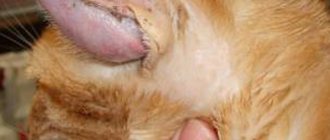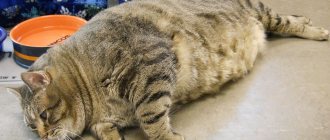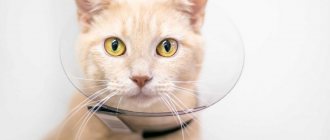Castration is a very common type of surgery in veterinary practice. In our country, surgical sterilization is used in more than 90% of cases. This is a simple, cheap and very effective method of depriving animals. It involves the use of general or local anesthesia. However, on thematic forums you can often read that in some places castration of a cat without anesthesia is in use... Is this really so, how dangerous (or not dangerous) is such an operation for the animal’s body?
What is cat castration
Castration is a procedure that results in the termination of the functioning of the sex glands (testes) in cats.
The intervention may be:
- surgical (removal of gonads);
- traumatic (as a result of an injury);
- medication (taking contraceptives);
- radiation (with radioactive irradiation).
In the understanding of most people, castration of cats means an operation to remove the gonads from the scrotum, as a result of which the animal is deprived of the ability to reproduce.
In veterinary terminology, castration of female dogs and cats has been replaced by “oophorectomy” (removal of the ovaries) to make it easier to understand the wishes of the owners.
You can often come across the term “sterilization”. This is another operation in which nothing is removed, but only the spermatic cords in cats or the oviducts in cats are ligated. This intervention also deprives the animal of the opportunity to have offspring, but does not eliminate restless behavior and bad habits (marking, meowing loudly). It is for this reason that sterilization surgery is not popular among cat owners.
Cost of the procedure
The price of cat castration is influenced by factors such as the level of the clinic, the method of intervention, and the city. The price includes the type of anesthesia, postoperative care, therapy before and after the procedure. The average price for surgical intervention ranges from 900 to 1500 rubles. In some hospitals the price reaches 7000-8000 rubles.
Removal of testes from domestic animals is caused by the need to pacify sexual instincts. There are several methods of castration: open, closed, medicinal, and vasectomy. Postoperative care and properly selected nutrition will ensure a positive effect from the procedure and extend the years of your pet’s life.
The article is for informational purposes only. Contact your veterinarian!
Why is the procedure needed?
Castration of cats is accompanied by the removal of reproductive organs (testes), in which the main male hormones (responsible for behavior) are produced and the process of formation of germ cells (spermatogenesis) occurs.
That is, you need to castrate a cat in the following cases:
- if there are no plans to have offspring (especially important for cats walking outside or going to the country);
- damage to property in the house (leaving marks with urine), often for this reason cats are thrown out or euthanized;
- extreme aggression of the cat towards people and other cats in the house (the operation will make him a little calmer);
- when keeping a large number of pets in a crowded environment, in order to correct behavior in the group and prevent conflict situations (in circuses, shelters, pet cafes).
- for medical indications (development of cancer, genetic abnormalities, incurable viral diseases, injuries in cats).
Veterinarians and volunteers also recommend castration for abandoned cats that are in foster care while searching for a new family (such animals are more readily adopted from shelters as adults).
If the owner prefers not to castrate the cat, then it is worth taking care of finding a suitable pair and providing the cat with comfortable living conditions, taking into account its behavior (it is possible to use pheromones to calm it down).
Advantages of castration of male cats
There are many pros and cons of performing the operation in each specific case. The positive aspects in favor of the decision to “castrate the cat” are:
- increasing the life expectancy of a pet (castration has been proven to increase a cat’s life expectancy by an average of 2-4 years due to a reduced risk of developing sexually transmitted infections);
- calming violent and characteristic cats (the aggressor, of course, will not turn into a good-natured plush, but will become less excitable);
- the specific cat smell will disappear in the house (neutered cats have less persistent and odorous urine);
- if a genetic defect of the manufacturer is identified (a breeding cat was bred, but kittens were born from it with a defect in health or phenotype);
- you will not need to constantly buy hormonal contraceptives for your cat (they often cause the development of neoplasms).
Cons of the operation
If the pet owner doubts whether it is necessary to castrate a cat and does not know what this procedure entails, here is an explanation:
- cats castrated at an early age grow smaller (in this case, muscle mass and physical strength are meant) because testosterone production stops;
- cats of a rare breed with excellent qualities after the operation will no longer be able to take part in breeding;
- A cat can gain excess weight if its diet is not revised (neuters need to reduce the caloric content of food by 25%).
Important! After the operation, the cat’s hormonal levels will be adjusted within 1-2 months. It is during this period that old habits may appear as before, but gradually fade away. Therefore, pet owners should not expect that 2-3 days after castration the cat will stop marking or meowing loudly.
Preparing for surgery under local anesthesia
There are only four recommendations, but the success of the procedure and the duration of the recovery period largely depend on their implementation:
- It is strongly recommended that you make arrangements with your veterinarian so that the surgery is scheduled for the morning. What is this connected with? In this case, you can leave your pet at the veterinarian and finish your work day in peace. The specialist, after performing the operation, will keep an eye on the cat for several hours. If he notices signs that something is wrong, the problem will be much easier to deal with.
- Before the operation, a medical examination is required. Blood pressure is measured and urine samples are taken. This is especially important when the veterinarian has reason to suspect the presence of pathologies of the liver and kidneys (in this case, surgery is extremely contraindicated).
- It is strongly recommended to carry out a biochemical blood test at the stage of planning the operation. It is very important to evaluate liver enzyme levels. An increased volume of these compounds indicates dangerous liver pathologies. And in such cases, the introduction of any anesthetic drugs can be deadly! Therefore, it is better to find out about such problems in advance, and not at the moment when the cat begins to vomit during surgery or falls into a coma! It is worth noting that pathologies of this type are extremely rare in young animals (but it is still stupid to completely exclude their possibility).
- The veterinarian should explain in detail the advantages and disadvantages of local anesthesia (in relation to a particular case). You should always remember that even surgical castration, despite all its “harmlessness,” is still a full-fledged operation, during which something can always go wrong. Animals can have sudden, fatal allergic reactions to medications used by the veterinarian; they may have an underlying disease that no one knows about, but for which surgery is strongly discouraged. Although all this happens rarely, such cases are far from unique.
As a rule, this recommendation is given to owners of animals that are supposed to be operated on under general anesthesia, but still... Do not feed your pet 12 hours before the expected date of the procedure! In addition, about three hours before it is advisable to completely limit the animal to water. Following these simple recommendations significantly reduces the standard risks that arise during and after sterilization.
When should a cat be neutered?
According to veterinarians, castration should be prescribed when the cat reaches sexual or full anatomical maturity. This period is individual for each breed.
Average figures range from 7-12 months to 2 years. Some breeds of large cats, such as Maine Coon, Ragdoll, Savannah, Norwegian Forest, Houseie, Chartreuse, are considered slow maturing, as they reach anatomical maturity only by 3-4 years.
Important! It is necessary to castrate the cat before the first mating. Otherwise, in the first time after the operation, the desire will remain (since the pituitary gland also produces sex hormones, but in smaller quantities), the pet will remember the meeting with the cat and want to continue.
Castration of a cat at an early age
If you operate on a cat before it reaches 7 months of age, the body will develop more slowly - the formation of the skeleton and the growth of muscle tissue will slow down.
Shelters often neuter kittens at the age of 5-6 months. The reason for this is the ability to eliminate general anesthesia, which has a harmful effect on underdeveloped kidneys and liver.
Carrying out surgery at the age of 7-9 months
The age period from 7-9 months to 1 year is considered the most favorable for castration of cats. It is at this time that most pets tolerate anesthesia calmly, so the risk of complications after surgery is minimal.
In adulthood
The latest age for castration of a healthy cat is considered to be 7 years old. The disadvantage of performing an operation in adulthood will be the persistent consolidation of behavioral habits, which will be almost impossible to get rid of.
However, for an elderly “patient” the doctor may prescribe castration for medical reasons. It will be more difficult for such a cat to endure anesthesia, and recovery will take much longer.
Suitable age for sterilization
Today, veterinarians around the world believe that it is best to sterilize an animal at the age of five to seven months.
Remember! The body of young kittens is more labile and adapts much faster to life without sources of sex hormones.
An exception to this rule are representatives of the Persian and British breeds: they are characterized by slower development, and therefore these cats should be castrated no earlier than seven to eight months, and some experts recommend waiting until a year.
It is in these cases (again, with the exception of the Persians and the British) that it is permissible to perform castration without anesthesia, using only local anesthesia. And the point here, by the way, is also in the biochemical characteristics of the pets’ body, which manifest themselves precisely at this age.
They consist in the fact that the liver and kidneys of kittens in this case are not yet fully developed. They may either not completely metabolize the agents used for anesthesia, or they may convert them into compounds that are deadly to the entire excretory system. Therefore, giving children general anesthesia is simply dangerous : no one can say for sure exactly how the medications will affect the pet’s body. Moreover, it is in “young people” that the development of severe side effects from general anesthesia is most often recorded, up to a medically induced coma (and animals rarely emerge from it).
Thus, all veterinarians agree that up to seven months, general anesthesia is not only unnecessary, but even dangerous. Exceptions are made only in some individual cases, and before performing the operation, the animal must be subjected to a full medical examination.
Preparing an animal for castration
Castration of a cat, like any operation, carries certain risks to life, so careful preparation and examination of the animal is necessary.
What you need to do to keep your cat healthy:
- Vaccinate the kitten at 8-12 weeks of age, repeat immunization a month later (use complex vaccines).
- It is advisable to wait until the teeth change (about 8-9 months) and carry out preventive treatment against worms.
- After deworming, vaccinate the cat again and wait 2-3 weeks.
- Operate on a clinically healthy cat.
Pedigree cats (with a predisposition to various diseases) must be examined. The presence of problems with the cardiovascular, respiratory or urinary systems may be a contraindication to castration. If this is neglected, then during anesthesia the load on organs with pathologies will increase and the animal may die.
Tips for preparing your cat immediately before surgery:
- A 12-hour fast before arriving at the clinic (this is recommended due to the appearance of nausea after premedication, so that the animal does not choke on vomit);
- do not give the cat water 1-2 hours before surgery;
- put the cat’s favorite blanket or the owner’s clothes in the carrier so that familiar smells calm him down when he’s stressed;
- you can spray the carrier with a spray with cat pheromones or sprinkle a little Matatabi (Japanese wild plum powder) - these products will also calm the cat;
- arrive at the clinic at the appointed time so as not to wait long in line and not increase the stress factor for the cat.
Carrying out the operation
The castration procedure is divided into the following stages:
- Anesthesia.
- Removal of testes.
- Coming out of anesthesia.
Anesthesia
For ethical reasons and to ensure the convenience of the surgeon, the cat is immobilized and immobilized. For emasculation, general anesthesia is used. At the doctor's discretion, sedatives may be prescribed 1-2 days before surgery. Before administering the drug, a premedication procedure is performed - an injection of drugs is given to prevent side effects. Each veterinary clinic uses its own set of medications.
The traditional anesthetic is Xylazine, which is administered intramuscularly. The advantages are ease of administration and relatively low price. The disadvantage of using the drug is a certain waiting period, individual for each cat. The duration of recovery from anesthesia is 3–24 hours. Advanced clinics use Propofol. It is administered intravenously. Anesthesia occurs immediately, recovery from it is 1–2 hours. The disadvantage is the high cost.
Some clinics are convinced that traditional drugs only cause muscle relaxation and do not eliminate pain sensitivity, so they additionally perform local and intratesticular anesthesia with Lidocaine. Experienced veterinarians use conduction anesthesia, in which an anesthetic is injected into the epidural space.
Removal of testes
Several methods of castration of cats have been developed, but the most reliable and relatively inexpensive is considered to be the traditional, open method. In the clinic, instruments are sterilized; at home, a veterinarian performs castration with disposable ones. The surgical field is prepared. They pull back the cat's scrotum and cut all the layers. The exposed testis is removed, the spermatic cord is securely tied up and cut five millimeters below. The wound surface is sprinkled with an antiseptic. Apply 1-2 stitches or do without this procedure.
For old cats, in order to avoid the occurrence of an inguinal hernia, a closed method is used. The scrotum is cut, the vaginal membrane is twisted, stitched with thread, a ligature is applied, cut off, and cauterized with tincture of iodine.
During the operation, the surgeon should protect himself from getting a stream of urine in the face, which is thrown out involuntarily by the animal during the operation.
Castration of cryptorchids
A hereditary developmental anomaly is considered to be cats whose testes do not descend into the scrotum and remain in the groin or abdominal cavity. In such males, increased sexual desire is observed, accompanied by aggressive behavior. A distinction is made between unilateral cryptorchidism, when one testicle is present in the scrotum, and bilateral.
Most often, the testis is found under the skin in the cat's groin. Removal is carried out in a closed manner. Sutures are placed in two layers - on triglyceride fiber and skin. The normal testicle is excised in the usual manner. If the testes remain in the abdominal chamber, abdominal surgery is performed.
Cryptorchid cats are castrated not only for the purpose of correcting the animal’s behavior. Such males should not be allowed for purebred breeding. In addition, malignant tumors often develop in the undescended testicle.
If cryptorchidism is detected in a cat, there is no need to rush into surgery. Sometimes the testicles descend into the scrotum on their own. If this does not happen upon reaching one year of age, removal is carried out.
Castration
Coming out of anesthesia
The cat recovers from surgery within 24–48 hours. He refuses to eat because he feels nauseous. The movements are uncoordinated, the cat needs the care and affection of its owners. This is why felinologists recommend not leaving the operated animal in the clinic. He is shivering due to hypothermia, so the cat needs to be placed in a warm place and covered with a blanket. 5 hours after the operation the animal must be given water. Some veterinary clinics may offer the owner an additional service to remove the cat from anesthesia.
The cat comes out of anesthesia
Anesthesia (narcosis) before surgery
Anesthesia (pain relief) is necessary to protect the cat from severe physical pain and psychological shock during surgery.
During castration, general anesthesia (anesthesia) is usually used - deep sleep with complete loss of consciousness, which is carried out after premedication.
Premedication is the preparation of a cat for general anesthesia, which includes the administration of:
- muscle relaxants (drugs to relax muscles);
- antiallergic drugs (in the presence of individual intolerance to the components of anesthesia);
- medications to reduce salivation (so that the cat does not choke on saliva);
- heart medications;
- medications to improve blood circulation in small vessels and stabilize blood pressure in a cat.
Thus, when a cat is admitted to the operating table, premedication is first administered, and then the animal is placed under deep anesthesia.
General anesthesia can be inhalational (or gas) and non-inhalational. The choice of method falls solely on the shoulders of the veterinary anesthesiologist based on the patient’s individual indications, and is also determined by the technical equipment of the clinic.
Non-inhalation anesthesia for cats
Non-inhalation anesthesia during surgery means administering drugs to the cat intramuscularly or intravenously.
Intramuscular anesthesia is inexpensive and more common. A significant drawback is that it is difficult to control, so the animal will take longer to wake up. But doctors found a way out - using neutralizers to speed up the cat’s awakening.
Intravenous anesthesia, on the contrary, is more convenient to use, but more expensive. Animals wake up easier and faster, with no side effects.
Inhalation anesthesia
This type of anesthesia involves the introduction of “sleeping” gas into the cat’s respiratory tract. It is used during long-term operations, since it allows you to reduce the consumption of potent medications and minimize their negative effects on the body.
Gas anesthesia does not cause muscle relaxation and does not relieve pain, so it is used only for painless diagnostic procedures (computed tomography or MRI) or as part of a complex anesthesia.
Important! Inhalation anesthesia during surgery in veterinary practice involves inserting a tube into the trachea of a cat that is already in a medicated sleep.
Combined anesthesia during surgery
This is the combined use of intravenous (intramuscular) anesthesia with inhalation. It is used for cats if there are any contraindications due to health conditions or individual sensitivity to other anesthetic drugs.
Positive and negative
From the owner’s point of view, the positive consequences of emasculation are the prevention or cessation of the pet’s sexual behavior. He will stop marking space, shouting, and attacks of aggression will stop.
The negative aspects of emasculating a cat is the risk of his death on the operating table due to intolerance to anesthesia. Your pet needs care on the day of castration. Therefore, you will have to take a one-day vacation. And finally, preparation for the operation and its implementation lead to additional costs. In addition, castrati need higher quality and more expensive food. But animal owners living in high-rise apartments have no other choice.
The cat marks the territory of the slipper
Castration methods
There are several ways to castrate cats, namely:
- Surgery to remove the gonads (sex glands) is a classic option. Testes are removed from cats. Neutering a cat involves removing the ovaries.
- Sterilization of a cat without castration is ligation of the spermatic cords, and the animal retains the behavior of a “ladiesman” and all its habits, but it cannot impregnate the cat.
- Medical castration is the suppression of desire in a cat through the use of hormones.
Important! The choice of method for castrating a cat depends on the wishes of the owner, but he should study the positive and negative aspects of each method.
Preparing a cat before castration
The health of the pet is one of the fundamental conditions for the operation. The importance of this point increases even more if castration under general anesthesia is planned. To find out whether a small patient is ready for the upcoming procedure, the first stages of preparation include taking tests of various types:
- examination by a therapist, cardiologist;
- undergoing cardiac ECHO;
- taking urine and blood tests.
If the results of the study do not reveal clinical abnormalities, a time can be set for castration.
It will be better if the cat spends several postoperative days with one of the family members. Therefore, you need to choose the date of the procedure, taking this factor into account.
During the preliminary examination, the priority goal is to identify deviations that could affect the success of the planned operation.
Classic surgery
Classic castration takes place in several stages, the whole process takes no more than 1.5 hours (from the moment of admission to the clinic):
- Examination of the animal, administration of premedication, induction of anesthesia.
- Fixing the cat on the table in a dorsal position or on its side with limbs stretched.
- Shaving the area of hair on the scrotum and preparing the surgical field.
- Opening the scrotum with a scalpel, cutting the fascia and membranes, pulling out the testes.
- Ligation of the spermatic cords with a special suture and cutting off the gonads.
- Reposition the stump back, the incision is not sutured.
- The wound is treated with antiseptic agents.
During the castration process, only the testes with appendages and part of the blood vessels are removed; the remaining organs and glands of the reproductive system remain intact.
Medical (chemical) castration
An alternative to surgical castration is hormonal contraception. It allows you to temporarily stop the cat’s suffering, reduce his desire and craving for dates with cats.
Many owners of cats often resort to this method of castration, but they are forced with enviable regularity to make trips to the pet store for veterinary contraceptive drugs such as “Sex Barrier”, “Gestrenol”, “Ex-5” (“Ex-7.5”) , “Countersex”, “Pillkan 5”, “Ovostop”, “Stop Intimate”.
There are two types of medical castration:
- The use of hormones internally (in the form of drops, tablets, sugar cubes) or externally (drops on the withers). The essence of the method when taking drugs orally is a short-term effect on the animal’s hormonal levels and suppression of sexual desire. Usually used at the beginning of the “cat wedding” period. The drug "Ovostop" (new in this area) is applied to the withers and has a long-term effect (from 2 to 6 months). It prevents the onset of estrus in cats and suppresses sexual desire in cats.
- Subcutaneous implants (capsules with the drug) are an innovative method of contraception for animals. An example of a drug is “Suprelorin”. The essence of the method is that a capsule with long-acting hormones is implanted under the skin of the cat, which very slowly dissolves, releasing the active substance (it affects the pituitary gland, the production of the hormones FSH and LH is inhibited, spermatogenesis stops and the level of testosterone in the blood drops). After 6 weeks, infertility sets in and lasts for six months. The procedure must be carried out exclusively by a veterinary specialist.
The undoubted advantage of chemical castration is the reversibility of the process and the complete restoration of the pet’s reproductive functions. However, you should not use these methods for a long time and more than 3 times in a row, since there is a high probability of developing side effects (disorder of the reproductive cycle in breeding cats, development of inflammatory processes, cancer).
Important! Before using any hormonal drug, you must carefully read the instructions and follow the specified recommendations on dosages and timing of use.
Veterinarians strongly recommend that owners of animals who use hormonal contraception undergo examination every 2 years for early detection of characteristic pathologies.
Radiation castration
Another method of non-surgical castration is dosed irradiation of the cat’s gonads with a radioactive substance. This leads to an immediate decrease in sexual activity, up to complete extinction.
This method carries a high risk of developing malignant tumors in the future, so it is practically not used for domestic animals.
Treatment for worms
How long should you pet a cat to relieve stress?
Typically, deworming treatments are carried out four times a year, every three months (for example, before the start of each season). However, even if the animal’s owners strictly follow these rules, an extraordinary treatment must be carried out a week before castration.
To do this, you need to give the cat an anti-worm medication prescribed by your veterinarian. The dosage is determined depending on the weight, age and health status of the pet, so it is calculated individually each time.
If the animal spits out part of the medicine, you should not immediately give a second portion to avoid an overdose. It is advisable to repeat the treatment the next day.
Attention! You should not limit yourself to a one-time treatment against helminths. After some time, it is recommended to repeat the procedure in accordance with the instructions on the package. In parallel with the treatment against helminths, you can apply drops of fleas, ticks and other parasites to the cat’s withers.
Possible complications in a cat after surgery
During the first time after castration of a cat, the following may occur:
- minor bleeding from the wound, which stops on the same day and does not pose a threat to the animal’s life;
- inflammation of the scrotum, which causes swelling of the tissue around the wound, an increase in local temperature, lethargy, and poor appetite;
- abscess as a result of infection of the wound (a high risk of infection is observed if you let the operated cat go for a walk in the first days after castration).
To minimize the development of side effects, you need to carry out mandatory antiseptic wound treatments daily (the first 2-3 days), do not let the cat outside and keep the litter tray clean.
If castration was performed on a 6-8 month old kitten, then in the postoperative period it is important to protect it from communication with uncastrated cats in order to avoid conflict situations and allow the young, weakened body to recover.
When castrating cats (when the uterus is not removed), the worst consequence may be the early development of oncological processes, which will lead to the death of the animal. This is why veterinarians prefer ovariohysterectomy (removal of the cat's ovaries, uterus and oviducts).
Consequences
The consequences of the operation include complications after emasculation, predisposition to diseases, as well as changes in behavior.
Post-castration complications
During the operation, bleeding may occur, which is eliminated by the surgeon. Primary hemorrhage is less dangerous than secondary hemorrhage, which occurs suddenly, after a few hours, and can cause death from large-scale blood loss. Therefore, the animal owner needs to maintain contact with the operating veterinarian.
Hernias
Most often, the problem arises when castrating an elderly patient using the open method. But even in young cats, due to a congenital anomaly, the inguinal rings may be too wide, the vaginal membrane, the stump of the vas deferens, intestinal loops or omentum fall out. The pathology is corrected surgically.
Wound infection
The infection is caused by a cat scratching or licking the wound surface. For protection, a blanket is put on the body of the operated animal. To prevent the cat from licking itself, an Elizabethan collar is used. The cat litter box is cleaned of feces twice a day.
Predisposition to diseases
For emasculated cats, two metabolic pathologies are characteristic - urolithiasis (urothiasis), as well as obesity and its consequences.
Urolithiasis disease
The disease occurs as a result of drinking poor-quality water, but more often due to poor nutrition. Economy-grade feed, fish, and meat trimmings lead to an excess of nitrogenous components. They are toxic, and the cat’s body eliminates them in the form of sparingly soluble uric acid salts. When precipitated, stones are formed, creating obstacles to the outflow of urine. Mostly males suffer due to the tortuosity of the urethral meatus.
After emasculation, the cat's body continues to grow, but the lumen of the urethra, the development of which is influenced by androgens, remains unchanged. This is the main cause of the disease. You can prevent urotiliasis by using soft, preferably bottled, water, as well as food for castrated animals. You cannot treat your pet to fish, meat or human food.
Very fat cat
Obesity
Depriving a male of his manhood leads to hormonal modification, which negatively affects mobility. Obesity causes diseases such as:
- cardiac and renal failure;
- urothiasis;
- constipation;
- diabetes;
- arthritis;
- malignant neoplasms.
You can get rid of excess weight by limiting the amount of food, as well as by arranging active games. The apartment should have toys - “tall tree”,
"Tall tree"
House for a cat, teasers, game tracks, wind-up mice, etc.
House for a cat
Postoperative care for animals
Caring for an operated cat includes the following:
- keeping in a warm, clean and dry room without going outside;
- the location of the cat's bed or house on the floor (during the process of recovery from anesthesia and the first time after it, unsteadiness of gait and weakness of the pelvic limbs are observed);
- put the cat on a diaper (temporary urinary incontinence may occur);
- place a bowl of warm water next to it (after anesthesia there is always a dry mouth);
- feed the cat only soft, complete food (special dietary food such as pates is a good choice);
- treating the wound with antiseptics (Terramycin spray, hydrogen peroxide);
- help the cat perform the first toilet after anesthesia (take it to the tray and hold it when weak).
As a rule, there are no negative consequences after castration of a cat if the owners take care and follow all the recommendations of the veterinarian.
Preparation
The cat’s body needs to be prepared for surgery. To insure against possible complications during surgery, it is necessary to carry out the following manipulations:
- Visual inspection.
- Cat thermometry.
- Determination of breathing rate and heart rate.
- Blood analysis. Particular attention is paid to coagulation indicators, as well as hemoglobin levels. If abnormalities are found, the cat must be cured before surgery is performed.
- Urine examination. Some breeds are prone to urothiasis. If symptoms of the disease are detected, the cat owner is offered to carry out therapeutic procedures or refuse surgery.
- Examination for ecto- and endoparasites. Worms and fleas reduce a cat's immunity. This contributes to the occurrence of postoperative complications.
- Completing scheduled vaccinations. The cat may be in the incubation period, so after vaccination it is monitored for two weeks. If the cat is clinically healthy, it is operated on.
- Before castration, the cat is not fed for half a day and does not drink for 2-3 hours to avoid vomiting.
Taking blood from a cat for analysis
Where is it better to have surgery: at home or in a clinic?
The only correct answer to this question is in a veterinary clinic equipped with a surgical room. There, the air is constantly sterilized and cleaned using special disinfectants.
A comfortable environment for anesthesiologists and surgeons is also important and helps reduce the risk of complications during surgery.
In the event of a sudden stop in the animal’s heartbeat or cessation of breathing, the presence of special equipment in the clinic will allow the cat to be resuscitated and save its life.
Castration outside the clinic (in an apartment, at a dacha, in a zoo shelter trailer) is permissible only in cases where it is impossible to visit the clinic or there are a large number of animals that need to be operated on at the same time. If a surgeon is called to your home, the doctor takes with him the most necessary instruments and medications.
Care before surgery
There is a set of established rules and recommendations for the care of animals undergoing surgery:
- absence of direct contraindications for castration of a cat;
- normal appetite;
- normal body temperature;
- no problems with stool;
- a deworming procedure and general treatment against parasites were carried out;
- good tests and vaccinations done on time.
If owners have any doubts about the health of their pet in the preoperative period, they should immediately inform the veterinarian. Adult cats over 5 years old are recommended to undergo general blood and urine tests first.
Feeding a neutered cat
Cats after castration need to change their usual feeding diet due to the fact that after a restructuring of metabolism, the need for energy will decrease by 25%.
If the cat is on natural feeding (meat, fish, dairy products, porridge), then it is worth reducing the amount of fatty food or reducing the portion.
When feeding commercial food, it is wiser to switch to a preventive diet marked “for castrated and sterilized cats.” In addition, they affect genitourinary function and help prevent various ailments.
Sterilization and castration - what is the difference?
I would like to start by distinguishing between different operations, which many cat owners can hardly distinguish between. An erroneous understanding has taken hold that sterilization is associated with females, and castration with females. Some owners even suggest that these two words are synonymous and mean the same surgical procedure.
Sterilization requires a lot of effort from the doctor and is more expensive than castration
Fertile ground for such a misconception was created by many veterinary websites that used these concepts without detailed explanation. Meanwhile, the rub lies in the details. So why is spaying more common in the context of cats, and castration more common in the context of males?
The answer lies in the way two related operations are performed. Castration is a more radical version of sterilization and involves getting rid of all reproductive organs, without exception. Due to the peculiarities of physiology, this option is, indeed, more often practiced on males, since partial removal of the reproductive organs is useless in their regard.
Even if desired, the doctor is not always able to remove the uterus without harm to the health of the animal
Sterilization, on the contrary, leaves the reproductive “rudiment” intact, taking into account the loss of the ability to reproduce. Such a rudiment in females is the uterus, the removal of which, it would seem, is not necessary. It is enough to get rid of the ovaries, which produce sex hormones, to block the cat’s very need for a ligament. If you wish, you can castrate a cat, but most owners prefer to leave the uterus due to its “harmlessness”.
What's best for a cat?
As already mentioned, sterilization involves getting rid of the ovaries and preserving the uterus. What could be the consequences of such a medical move? The uterus is the sovereign organ in the abdominal cavity. Strictly speaking, it does not depend on the ovaries, and if they are removed surgically, the uterus will continue to exist. If its blood supply is normal, it will not atrophy and die.
Many veterinarians advise getting rid of both the ovaries and the uterus during sterilization.
However, it is worth considering that by leaving this organ, you expose the animal to all the dangers associated with this organ. Neoplasms, inflammatory processes and other malignant processes can happen to any cat, regardless of how attentive the owner was and how good the care was.
The most common ailment associated with the uterus is endometritis, which causes inflammation of its mucous membrane. This disease is very difficult to recognize. If the right moment for diagnosis and treatment is missed, the disease risks becoming acute and later chronic. Preserving the uterus can also be dangerous due to the appearance of a cyst, which in advanced cases will threaten the health of the pet.
Multiple uterine cysts in a cat
Recently there has been a tendency to abandon sterilization in its classical sense. Veterinarians do not consider it necessary to leave an organ that in the future can cause both the cat and its owner a lot of inconvenience. Therefore, the modern version of sterilization is actually close to castration and involves the removal of all organs that are in one way or another involved in the process of reproduction.
Nowadays, sterilization is as close as possible to castration in its function.
By the way! For ease of designation, many veterinary clinics continue to use these two terms, giving them different meanings. Therefore, before “sterilization”, check with your veterinarian what is included in the “kit” of this procedure.
Myths about castration
There are many myths about castration, here are the most common:
- After castration, the cat will become fat and clumsy. If you take care of feeding it, do not leave a bowl of food in the public domain, and ensure your pet has an active lifestyle, this will not happen.
- The cat will stop going out and catching mice. Behavioral reactions characteristic of predators do not depend in any way on the gonads and testosterone. Hunting behavior in cats is regulated by natural instincts. If a cat caught mice on the street before castration, then this skill will not disappear.
- Cats live shorter lives after castration. On the contrary, long-term observations show that if a cat is sterilized, he will live 1-4 years longer.
- All castrated cats suffer from urolithiasis. With proper feeding and annual preventive checks (urinalysis), this can be avoided.
- Neutered cats will look small and frail and will not be able to fend for themselves and defend their territory. A cat's phenotype is determined by genetic predisposition. The operation can affect the size of the pet only if it is performed at a very early age (5-6 months), then it is likely that the cat will grow small.
Castration and sterilization of cats today is so advertised and accessible that many people perceive it as an intrusive service from veterinary clinics in the pursuit of profit. This is partly true, since such operations are performed in clinics every day and repeatedly.
It is more correct to look at this procedure from a different point of view and imagine what could have happened in basements and on the streets if there had not been such a simple and inexpensive operation as castration. The worries and financial expenses of cat owners would increase significantly.
Post-operative care
For the first 2–4 days, the wound remains swollen and painful, and must be periodically treated with an antiseptic. On days 5–7, the site of intervention ceases to bother the animal. At this time, it is advisable to stop attempts to lick the defect by putting an Elizabethan collar on the cat. After each cat approaches the tray, it is necessary to clean it of excrement to avoid infection of the wound.
6 hours after the operation, the cat’s appetite awakens. For some time he will eat a little, but often. Regardless of what the cat ate before castration, it is advisable to switch it to premium wet food for the first 2-3 weeks, subsequently replacing it with cheaper dry food. The popular food Purina Pro Plan has a moderate price, which is on average 2.3 times higher than the budget food of the same weight of the Whiskas brand, and Kitiket – 3.7 times.











